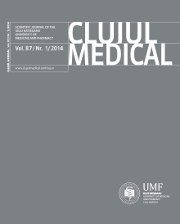Change in the Lower Limb Deep Venous Flow in Peripheral Atherosclerotic Arterial Disease
DOI:
https://doi.org/10.15386/cjm.2014.8872.871.mca1Keywords:
peripheral arterial disease, popliteal venous flow, venous thrombosis, risk factorsAbstract
Aim. This prospective study was undertaken to determine how peripheral atherosclerotic disease influences the flow in the deep veins of the leg.
Material and method. Thirty one subjects with peripheral atherosclerotic disease and 23 age matched control subjects were studied. The popliteal vein flow velocity was measured at rest and during reactive hyperemia by means of color duplex ultrasound scanning. Patient age, ankle-brachial index (ABI) and the presence of risk factors for venous thrombosis were also recorded.
Results. There was a negative correlation between the ankle-brachial index and venous flow velocity among subjects with peripheral arterial disease (p=0.001). There was a negative correlation between dyslipidemia and resting venous flow velocity (p=0.049). During reactive hyperemia, venous flow velocity increased less in subjects with peripheral arterial disease than it did in control subjects (p=0.007). The subjects with dyslipidemia showed no changes in venous flow velocity in reactive hyperemia measurements (p=0.908).
Conclusion. Increasing the venous flow velocity in peripheral arterial disease, may confer some protection against the deep venous thrombosis.
Downloads
Published
How to Cite
Issue
Section
License
The authors are required to transfer the copyright of the published paper to the journal. This is done by agreeing to sign the Copyright Assignment Form. Whenever the case, authors are also required to send permissions to reproduce material (such as illustrations) from the copyright holder.

The papers published in the journal are licensed under a Creative Commons Attribution-NonCommercial-NoDerivatives 4.0 International License.

